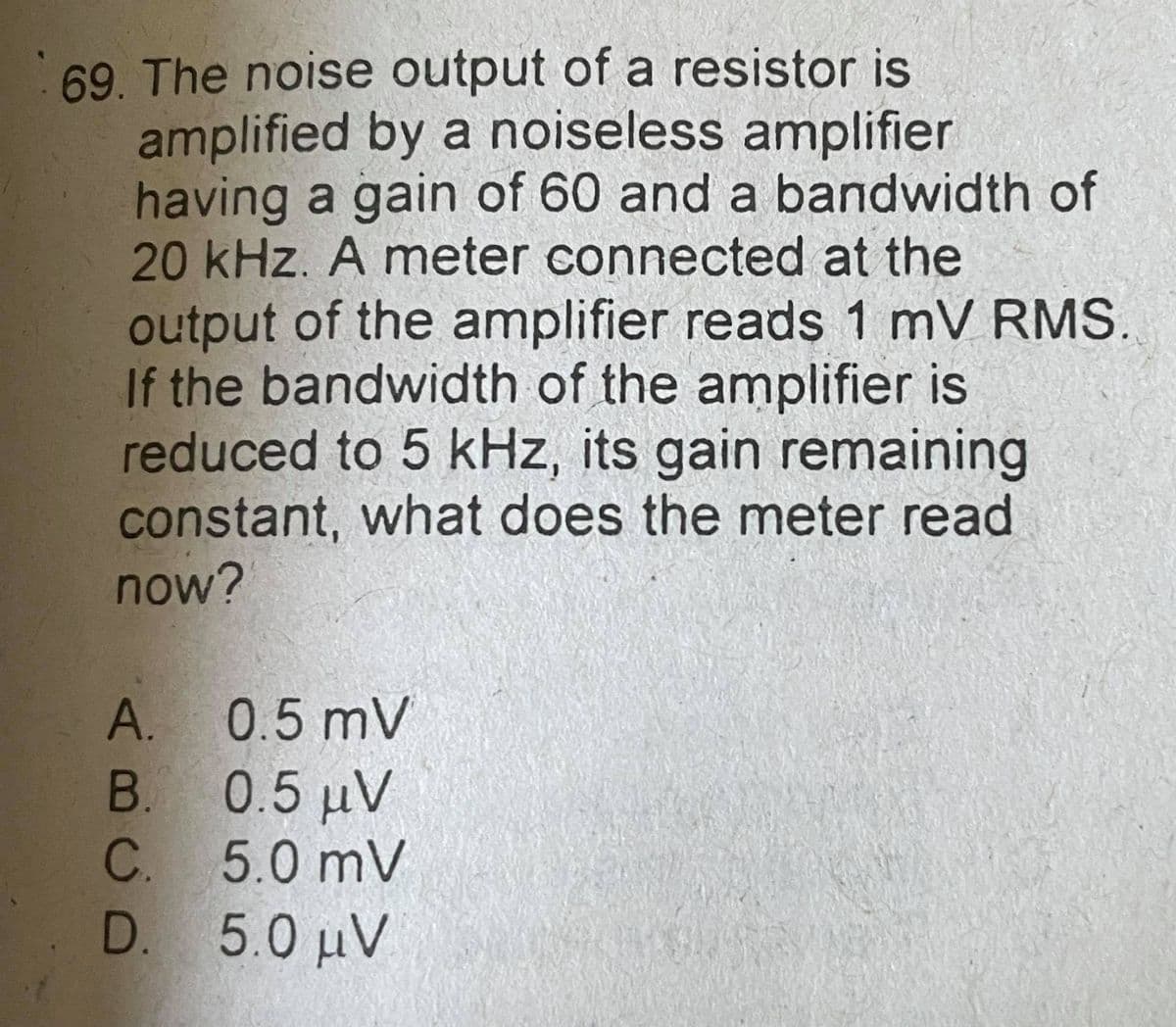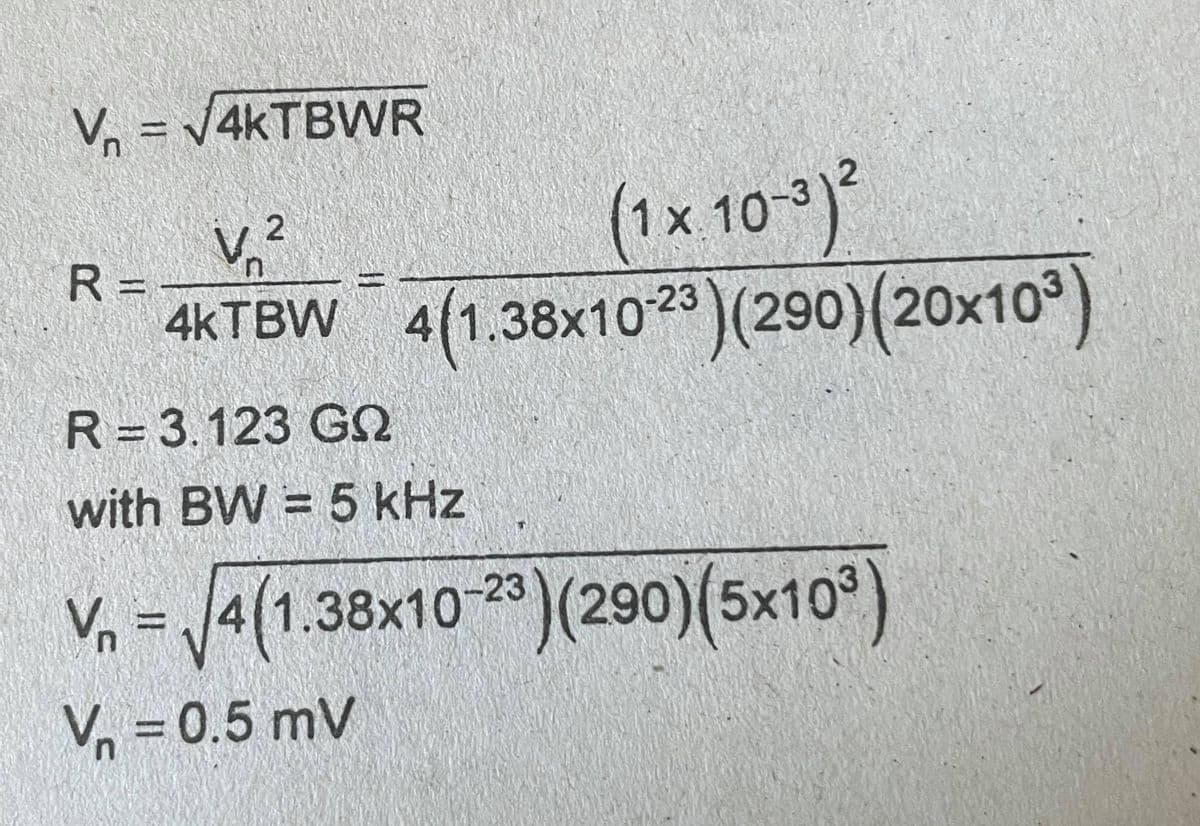The solution is already provided and my question is how did they calculate the temperature? How come it is 290K? Please provide a detailed explanation.
Q: 22 Use the Bi-Sb phase diagram (shown below) to locate the following points and indicate which of th...
A:
Q: Which of the following wave functions represents a solution to the Schrödinger equation for an elect...
A:
Q: Apply and Analyze 1. Three different fluids have the following specific weights: Fluid A's specific ...
A: Given: The specific weight of the liquids are given by ρA = 50 lb/ft3ρB = 80 lb/ft3ρc = 10 lb/ft3 Th...
Q: A charge distribution has the charge density p=Q{8(x-x,)-8(x+x, )} . For this charge distribution th...
A: Given, The charge density, ρ=Qδx-x0-δ(x+x0) The equation shows that the positive charge at x0 and ne...
Q: A particle executing SHM of amplitude 5 cm and period of 2s. Find the speed of the particle at point...
A: To find: Velocity (V)=? Given data- Amplitude (a)=5 cm Periodic time=2 sec At given pt. acceleration...
Q: Suppose the divergence of the electrie field in some spherical region is found to be V. E= Skr. Find...
A: Direction of the electric field depends upon the sign of the charge. For instance if the charge is p...
Q: In a physics lab, students are conducting an experiment to learn about the heat capacity of differen...
A: Given, First group, For lead, m1=1.5gT1=920Cm2=305gT2=160C Second group, m1=1.5g a. Equilibrium temp...
Q: D3.6. In free space, let D 8xyz'a, + 4xz*a, + 16r yz'a: pC/m2. (a) Find the total electric flux pass...
A: The electric flux through a given area is the number of electric field lines which will pass through...
Q: F2 = 400N 20 deg 20deg 45deg F1 = 300N X- 15deg F3 = 150N F4 = 250N
A: The vector F1 is directed at angle 45° along positive x-axis. The i^ component of vector F1 is F1×...
Q: 43. The escape velocity from the Moon is much smaller than from Earth and is only 2.38 km/s. At what...
A: Solution:-Given thatEscape velocity from moon (Vesc)=2.38 km/s=2380 m/sMolecular mass of Hydrogen (M...
Q: 4. The highest frequency of the X-rays produced in a X-ray tube operated at a potential difference o...
A:
Q: Find a Lagrangian corresponding to the following Hamiltonian: H
A: From question, H=12p1q2+2p1p2+q12 And Lagrangian can be written in terms of Hamiltonian that is, L=∑...
Q: vector B has a length of 64.0, and vector Ć has a length of 22.0. Find each magnitude and direction....
A:
Q: 2. Explain the variation of properties on reducing the size from bulk to nano.
A: Explanation: Nano dimensions corresponds to dimension of the order of 10-9. It is very small and obv...
Q: (a) A ball of mass 5kg falling underwater vertically faces a retarding force of magnitude 15kg/s tim...
A: Given,mass m=5kgretarding force =15vmg=50Nv(0)=-10m/sx(0)=-3m
Q: In the situation below a wire carrying a current I is near a square loop of wire also carrying a cur...
A:
Q: A free falling maSsive, charged particle is suddenly exposed to a uniform vertical magnetic field. W...
A: Lorentz force: Whenever a charged particle is subjected to move in an electric and/or magnetic field...
Q: 25. A skydiver weighing 180 lb (including equipment) falls vertically downward from an altitude of 5...
A:
Q: A piano tuner plays an out of tune A note on his piano and then strikes his 440 Hz tuning fork. He n...
A: Given: The frequency of the tuning fork is f1 = 440 Hz The beat frequency before loosening the strin...
Q: Given the vector field V=2x(-î)+2yĵ. 3.1 Conceptaulise V with a sketch. 3.2 Is V a source field or s...
A: Given: The vector field V→=2x-i^+2yj^ Solution: Part 3.1 Part 3.2 Write divergence of vector ∇....
Q: Consider a system has the wavefunction v(r)-8 exp(-ie where a and w are real constants a) Determine ...
A: The given wave function is ψx=B exp-λx+iwx where B, λ and w are constants. To determine: (a) The n...
Q: Find a Lagrangian corresponding to the following Hamiltonian: H = 2P.P; +gi)
A:
Q: 2–49. If F = 300 N and 0 = 10°, determine the magnitude and direction, measured counterclockwise fro...
A:
Q: A 2 kHz sound wave traveling in the x direction in air was observed to have a differential pressure ...
A: Since we only answer up to 1 question, we will answer the first question only. Please resubmit the o...
Q: 14. The smallest frequency that can be analysed by a NaCl crystal of interplanar spacing 0.281 nm be...
A: We can use Bragg's law to solve the question as it's about interplanar separation of NaCl crystal. B...
Q: What is the frequency of a photon .5 absorbed by the hydrogen atom to ?excite it to the third excite...
A:
Q: Suppose the divergence of the electrie field in some spherical region is found to be V. E = Skr. Fin...
A: To solve the problem, we will first use Gauss law in differential form to find charge density, and t...
Q: The x,y, and z edges of a rectangular parallelepiped are 1, 2, and 4 respectively. If the diagonal O...
A:
Q: The number of states in k space which holds all the electrons which have energies less or equal Fer
A: Fermi Energy refers to the difference in energy between the highest and the lowest occupied particle...
Q: Battery Air Fuel A fuel gauge uses a capacitor to determine the height of the fuel in a tank. The ef...
A: Given: The width of the fuel tank is w = 19 cm The length of the fuel tank is L = 12 cm The breadth ...
Q: Amoving particle encounters an external electric field that decreases its kinetic energy from 9790 e...
A: Concept: According to the work-energy theorem, the net work done on an object by forces equals the c...
Q: The base of a metal block, which is fixed in place, measures 29 cm by 29 cm, and the height of the b...
A: Given: The dimension of the base of the metal bock is 29 cm by 29 cm. Thus, the area of the base is ...
Q: The jet car is originaly traveling at a velocity of 10 m/s when it is subjected to the acceleration ...
A:
Q: In the system shown, currents flow from 4 infinitely long wires in the direction shown in the figure...
A: The magnetic field due to an infinite current-carrying wire is given by the formula B=μ0I2πr where r...
Q: It is desired to use the Window-Design method to design an FIR low-pass filter to meet the following...
A: To answer: (a) The suitable window to be used (b) The size of the filter
Q: Two charges, +7 µC and +15 µC, are fixed 1 m apart, with the second one to the right. Find the magni...
A: The two given charges are kept 1 m apart. Let q1=+7 μC=7×10-6 Cq2=15 μC=15×10-6 C A third charge, -...
Q: i) A particle of mass 2.66×10-26 Kg travels at a speed of 5.0x106 m/s perpendicular to a field of fl...
A: mass of the particle, m=2.66×10-26 Kg velocity of the particle, v=5.0×106 m/s Magnetic field, B=1.20...
Q: For a fluid element of velocity field V = yi + xtj, the total acceleration at x = y = t = 1 is a. i ...
A: Given, Velocity field, V→=yi^+xtj^ x-component of velocity, vx=y y-component of velocity, vy=xt Now,...
Q: Prove [Â, BĈ] = [Â, BJĈ + B[‚, ĈJ-
A: Using commutator Identities rules 1 taking minus as constant
Q: particle of charge = 7pC is located on the -axis at the point 5.1 cm. A second particle of charge = ...
A: Concept used: Electric potential is a scalar quantity. Net electric potential is found by taking sum...
Q: Use Ampère’s Law to evaluate ΣB||Δl for the current configurations and paths shown below. (Please i...
A:
Q: Monochromatic light is incident on two identical and parallel slits of Young's double-slit setup. Th...
A: According to the question, monochromatic light falls on two parallel and identical slits. Where, dis...
Q: Consider a system has the wavefunction w(x)-8 exp(-Ae+ x) where 2 and w are real constants a) Determ...
A: Normalized wave function: A quantum mechanical function ΨN is said to be normalized if it satisfies ...
Q: The equilibrium-constant expression depends on t of the reaction. O a. temperature O b. stoichiometr...
A: Equilibrium constant is the value of the reaction quotient of the chemical reaction at the equilibri...
Q: Calculate the resonance frequency and the corresponding wavelength for an electron in a magnetic fie...
A: The applied magnetic field, B=0.330 T The energy difference associated with a transition is ∆E=gμBB...
Q: Evaluate the commutator L,, L, L, . (a) ħ’L, (b) 0 (c) h'L, x. (d) h’L.
A: from the properties of commutator bracket we know that: A^,B^C^=A^,B^C^+B^A^,C^ -------(1)
Q: In a double-slit diffraction experiment, light of wavelength 600 nm is incident on the two slits. Th...
A: Monochromatic light incident on the double slit arrangement is diffracted by the small slits. These ...
Q: Car A is travelling on a north-bound lane of a two-lane straight highway with an initial velocity of...
A: More than three parts are required to answer, so the 1st three is answered. Initial velocity of car ...
Q: Consider a system of two levels E1= 0, g1= 1 and E2= 1.6 X102ºJ, g2 = 2 is populated by N atoms at t...
A:
Q: fuel gauge uses a capacitor to determine the height of the fuel in a tank. The effective dielectric ...
A: Given, dimension of tanks is, Length, L = 12cm width, w = 19cm breadth, d = 18cm height, h = 7cm Emf...
The solution is already provided and my question is how did they calculate the temperature? How come it is 290K? Please provide a detailed explanation.


Step by step
Solved in 4 steps
